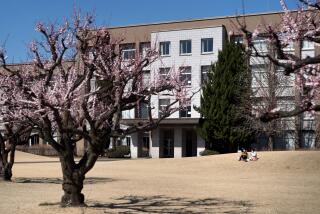Japanese Kindergarten: Fun, Not Books
- Share via
TOKYO — Every school day, Principal Mitsuko Kitajima stands at the gate--in rain, cold or wind--welcoming kindergartners and their mothers to school. The children’s respectful bows and matching bright-blue caps and coats are signs of Japanese discipline.
But once inside, it’s all fun for the kids of Oyata Kindergarten.
“It makes me happiest to see them smiling, to see the light in their eyes,” said Kitajima, who in her 35 years of teaching kindergarten has won awards for her research and safety record.
Japanese children, generally indulged and treated gently by their parents, enjoy their last truly carefree years in kindergarten, before plunging into the strict regime of formal education, Kitajima said.
Except for the most elite private schools, often affiliated with the best universities and linked in many minds with the best jobs later in life, Japanese educators seem to agree that carefree learning is what kindergarten should be about. The competition commonly associated with this nation’s educational system comes later.
The 101 children who spend four hours a day at Oyata seem happy and busy at their chores and play.
The 4- and 5-year-olds wipe the wooden patios with rags. They clean their classrooms and the cages of their pet rabbits and guinea pigs, play hide-and-seek, build cardboard houses and make as much noise as they want.
The school’s four teachers, with 20 to 30 students apiece, seem unperturbed by the chaos.
The 4-year-olds, who get the most direction, quietly follow the teacher through drawing exercises and a well-organized game. The 5-year-olds, busy with pets and projects, demand little attention.
Decide What to Do
“Each day, the kids decide for themselves if they’d like to be outdoors or inside, and if they want to draw pictures or play games,” said Kitajima. “We let them do what they want, although we sometimes have to persuade a child to try something new if he seems to spend all his time doing one thing.”
Almost half of all Japanese children start kindergarten at the age of 3, and 92% of all 4- and 5-year-olds attend kindergarten, according to Education Ministry figures.
Children living in nearby high-rise apartments have few chances to play in the sun or to meet friends outside of school. “It’s heaven for the kids,” Kitajima said.
The school, surrounded by an iron fence and shrubbery, has a playground and five large carpeted rooms. The children seem oblivious to the chill outside as they scamper in and out of the classrooms.
Like all public kindergartens, Oyata has a simple curriculum. The children never sit at desks and study, said Kitajima.
“We teach them how to hold a pen and brush, and they learn simple counting, but there are no lessons.”
More than half of Japan’s 15,156 kindergartens are private schools, most of which follow the same curriculum.
But children in the most prestigious private schools face such tasks as learning the abacus, writing and homework.
Intense Competition
Competition to get into top private kindergartens is intense. A place in one of the best schools gives a child a head start in the competition for jobs with top companies.
Tokyo’s most expensive kindergarten, connected with Aoyama Gakuin University, charged $9,925 per child in 1986. The average cost of private kindergarten is $2,164, and the government provides subsidies to parents who need them.
Most children in Japan can write the 51 characters of the Japanese alphabet and do simple addition by the time they enter elementary school, said Tomoko Suzuki of the Tokyo Children’s Research Center.
But the primary goal of Japanese kindergartens is to stimulate the children and teach them how to live with other people, Suzuki said.
“Children have such wonderful abilities, and we can nurture them while they have fun,” she said. “That way, when they start formal schooling, they’ll have developed as individuals.”
More to Read
Sign up for Essential California
The most important California stories and recommendations in your inbox every morning.
You may occasionally receive promotional content from the Los Angeles Times.













